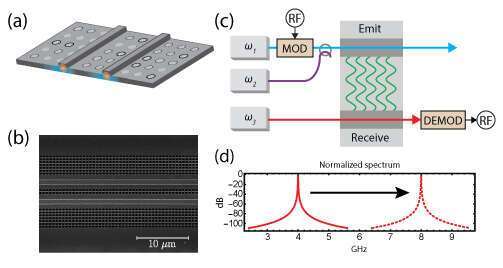
On Chip Tunable RF Filtering using Brillouin Scattering
We demonstrate tunable multi-pole microwave photonic filters using Brillouin-based interactions within new phononic emit-receive structures. In this system, the filter response is shaped using phononic crystal defect modes, and tuning is achieved using three-wave mixing.
Narrow band radio frequency (RF) tunable filters are an important building block of microwave systems [1]. Photonic-phononic-emit-receive (PPER) filter designs have demonstrated high link gain and narrow pass-bands [2, 3], making them a promising strategy for on-chip RF filtering. In a PPER filtering scheme, the RF signal is modulated on an optical carrier and directed into the ‘Emit’ waveguide of the device. The optical fields drive a narrow band acoustic field, modulating light guided in the ‘Receive’ waveguide. The output light is then demodulated to retrieve the filtered RF signal [3].
We use silicon ridge waveguides to guide spatially separated optical fields [3]. The modulated input RF signal is combined with a local oscillator tone, enabling the selection of the spectral band of the RF modulated signal that is taking part in the Brillouin interaction. This scheme allows agile tuning of the filter pass-band frequency. A suspended phononic crystal structure supporting coupled defect modes is designed to achieve a high order filter response [2]. This narrow band frequency response, with high out of band rejection, will determine the shape of the RF filter transfer function.
We will discuss the microwave link properties of the PPER filter such as link gain, dynamic range, noise properties, and frequency response based on an analytic model.

FIG. 1: (a) An illustration of the PPER device geometry. The optical fields are guided using ridge waveguides, while the acoustic fields are confined by a phononic crystal structure. (b) Top view of a PPER device using a scanning electron microscope. (c) A scheme of a PPER RF tunable filter. The RF signal is modulated on an optical tone ω1. A second laser at frequency ω2 is used as a local oscillator to generate an acoustic field in a narrow band around the acoustic resonance. A third optical tone ω3 is modulated by the acoustic field in the ‘receive’ waveguide, and demodulated to retrieve the filtered RF signal. (d) The normalized response of a PPER second order filter, simulated using typical values. Tuning the local oscillator tone shifts the passband center frequency.
[1] José Capmany and Dalma Novak. Microwave photonics combines two worlds.Nature photonics, 1(6):319, 2007.
[2] Heedeuk Shin, Jonathan A Cox, Robert Jarecki, Andrew Starbuck, Zheng Wang, and Peter T Rakich. Control of coherent information via on-chip photonic–phononic emitter–receivers. Nature communications, 6:6427, 2015.
shai.gertler@yale.edu

Powered by Eventact EMS